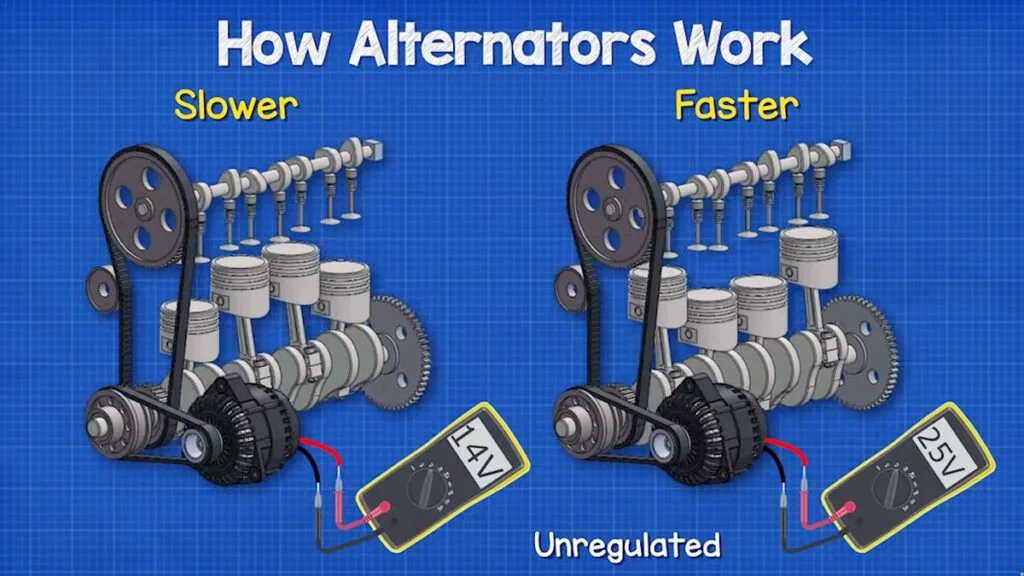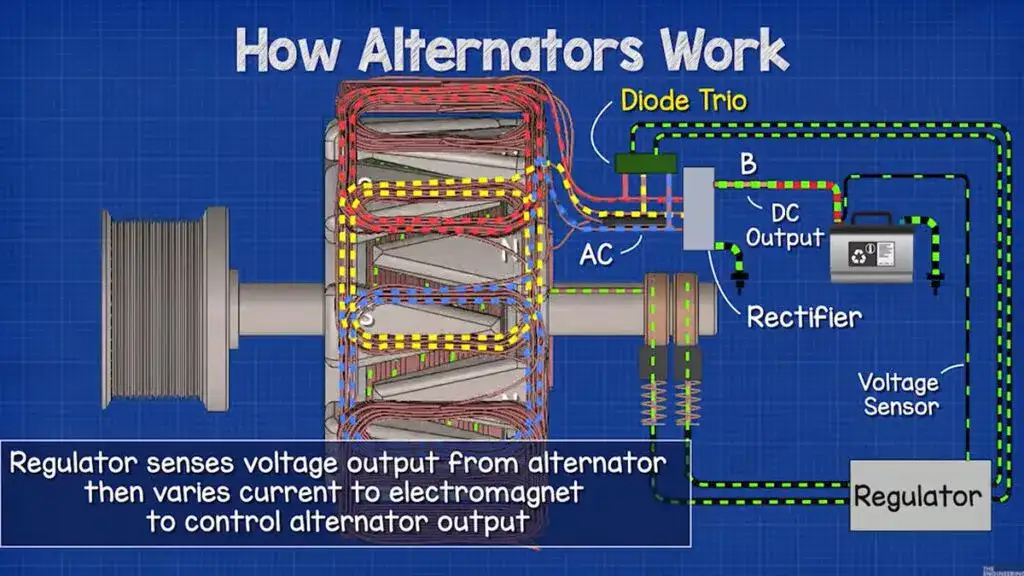What do you think does idling car charge battery? Yes, of course.
Car battery charges whenever the engine is running. That is the short answer for it, but in this article, we will discuss the main parameters in car battery charging. Stick until the end because we cover almost every aspect of car battery charging.
Why Your Car’s Alternator is Essential for Charging the Battery
Before talking about the does idling car charge battery, here, we’ll need to discuss one of the essential parts of your car: the alternator. Because the engine’s belt powers it, the alternator essentially functions as a generator or dynamo.

An alternator uses the spinning of the engine’s internal components to create electricity. Once converted, the battery may be recharged using this alternating current.
This procedure will continue as long as the engine is operating. Alternators may also be an issue if your battery begins to lose charge and you can’t figure out why.
How Long Should You Leave Your Car Running While Charging Its Battery?
It is theoretically feasible, although not very effective, to charge your automobile battery while it is idle. To get anywhere close to a full charge, you’d have to keep your vehicle running for many hours.
This is due to the first loss of charge while starting the engine. A few studies have indicated that this initial charge might take between 15 and 30 minutes to recuperate.
Taking your vehicle out on frequent trips will be a lot more effective approach to recharge your battery if you are able to.
The amount of time it takes to charge a battery depends on the kind of car and the type of battery it uses, but you’ll often find that it charges quicker this way. Make sure your battery is healthy and full of charge by using the trickle charger if you can’t do this yourself.
How Do You Tell if a Car Battery Is Getting Enough Power?
Also, how long does it take to recharge a vehicle battery? It’s difficult to estimate how long it will take to recharge a vehicle battery completely, but a multimeter may be used to measure the present charge.
Even while the engine isn’t running, a wholly charged automobile battery should have a voltage of between 13.7 volts and 14.7 volts, depending on ambient temperature. Your battery may need to be charged or possibly replaced if the voltage is lower.
What is the Charging Method?
The alternator is responsible for the whole charging process. An alternator’s only function is to provide power to the motor while the vehicle is in motion.
To put it another way, it’s an electro-mechanical device that’s difficult to grasp. The alternator’s shaft is attached to a drive belt, which your automobile’s engine uses to turn.
The shaft rotates in tandem with the belt. Many windings and rectifiers are connected to the post as it spins.
How a car’s battery is recharged is explained.
In the case of a magnet passing through a wire loop, a single direction of current is generated. A coil is just a group of loops bundled together into a single piece. “You’re experiencing the same thing since the rotor of the alternator is an electromagnet.
Windings create energy when the rotor rotates (coils of wire).
This voltage is controlled and sent to your car’s battery, where it may be recharged. The battery is now recharging, to my delight.
Using the idle mode to recharge the battery in the cold.
It doesn’t matter what time of year it is to recharge the battery. Batteries will charge more slowly at colder temperatures, which will improve when the engine heats up.
To avoid total battery depletion, you should avoid short travels during winter. The lack of adequate power results in the battery being drained more quickly than otherwise. It will be enough if you extend your drive by 10-15 minutes.
If most users start drawing their own power, it will be tough to recharge. Winter poses additional challenges due to the battery’s reduced current consumption.
How does the alternator assist in charging the battery when the automobile is idling?
The automobile industry is split on whether or not the alternator can charge the battery enough even while running at idle. A common misconception is that an automobile’s alternator can only provide power to the battery while the vehicle is moving. This is not true. The alternator’s ability to provide electricity does not rely on the vehicle’s wheels moving.

If you’re often stuck in traffic, what if your automobile is idling rather than moving? That will result in the engine shutting down, which is unusual unless anything is wrong.
The fundamentals of creating energy in an internal combustion engine may be summarized.
The automobile battery turns on an electric motor, also known as a starter, to provide the first crankshaft spin that delivers torque to the wheels to get the vehicle going.
When the engine is started, the battery produces a considerable amount of current, known as the starting current. This current may reach 300 to 400 Amperes.
The free tail part of the crankshaft is often used to hang a variety of belt drives in autos. Smaller amounts of torque are utilized to turn an alternator shaft in a car: the alternator rotor and the engine crankshaft spin in unison.
The vehicle’s alternator consists of a rotor (which rotates) and a stator (which is fixed), both of which have windings. AC is converted to DC, and the resultant current is then delivered to the vehicle’s battery for charging.
There is no requirement for a vehicle to be moving for this process to operate; the crankshaft’s rotation generates enough electricity to power the car’s battery and other essential components when the vehicle is stationary.
The Check Engine light coming on could mean a variety of things, from an alternator that isn’t charging correctly to a problem with the fuel mix. If this light comes on, don’t ignore it. – itismycar.com
FAQs related to Does Idling Car Charge Battery.
How long should I idle my car to charge the battery?
A brief drive or idling for 10 to 15 minutes once a fortnight may be enough to maintain the battery charged in any of these automobiles, as long as you do it once every two weeks. Taking a half-hour trip once a week could help slow down sluggish cranking.
Does the revving engine charge battery faster?
However, as your engine revs up, so does the alternator… In this technique, the alternator’s whole output may be used to recharge the battery. Once the engine is running, you may increase the revs to help charge the battery more quickly, but just driving the vehicle is the most efficient method.
We hope that after reading our explanation, you have the answer to the problem “Does Idling Car Charge Battery” If you have any additional questions, please leave a comment below, and we will be happy to assist you further. Check out this link for a review of the “What Year TDI“. Thank you very much.
